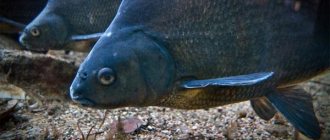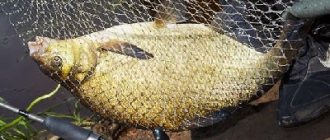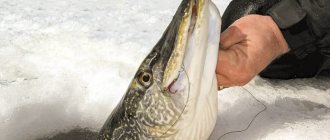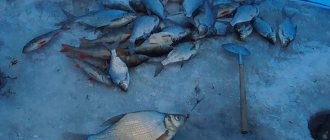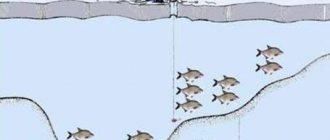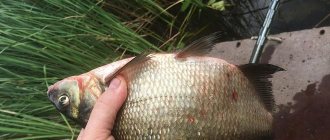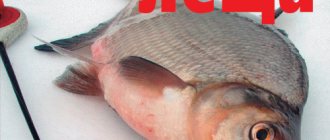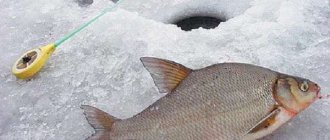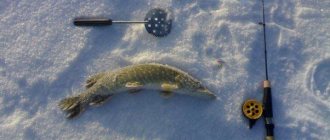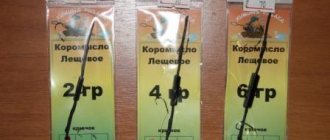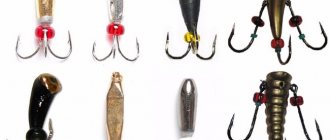Catching bream on the first ice requires knowledge of its stopping places and behavioral characteristics. At the beginning of winter, when the reservoir has just become covered with ice, any other fish bites, but not him. Bream begins to take an interest in bait only a couple of weeks after freeze-up.
Gathering in groups, this fish concentrates near wintering pits, coming out to feed only at specific hours. To get a catch on the first ice, you need to find ways to move a school of bream, their location, and develop a square, making holes in different directions.
Where to look for bream on the first ice
With the onset of cold weather, the behavior of bream in the first ice changes, changes occur, like other underwater inhabitants during this period. Gathering in numerous schools, bream and bream live on:
- Areas with calm water or moderate current. Fish can stay especially long in places where food is carried away by the flow of water.
- Places with great depth and clay bottom, if fishing is carried out on a reservoir, large river, lake. It is also possible to explore areas where the bottom is covered with silt. If the hunt is carried out on a small river, then the “troughs” - long holes, deep areas located along steep banks - turn out to be the most productive.
- Territories with heterogeneous bottom topography, where food accumulation occurs.
- Underwater heights. These are the so-called tables; fish actively feed here. The best place to look for bream is in bays where there are areas with weak currents, and nearby river beds, slopes of holes, ledges on the side of the incoming current.
Considering that bream on the first ice shows increased demands on the saturation of water with oxygen, you should not look for it in heavily silted areas with calm water. In such places, bottom sediments begin to actively rot, which discourages peaceful fish from them. Often schools of bream migrate to shallow water, crossing currents to find food.
Having spent energy, the fish stops after such transitions to rest, choosing places with:
- sunken trees;
- large stones;
- rocky ridges.
Fishing for bream in winter in the first ice on such trails often brings a rich catch.
Tackle
To catch bream on the first ice, use a jig or float rig. It is recommended to use 0.14 mm fishing line. However, practice shows that moving from this diameter to 0.11 mm can double the bite.
Bream can be caught well on the first ice if the tackle is selected taking into account the weight of the fish, the weight of the bait, etc. This is mainly noticed in the evening, when the holes are re-fed. For example, in the morning the bream was active on a 6mm jig using 4 bloodworm larvae, and in the evening it can take a jig with a diameter of 3mm and one larva.
Read! Fishing for bream in early autumn on picker
Naturally, in a couple of weeks the fish will go to their permanent camp sites. But it is recommended that after the first fishing, you return to those places where the fish were more active. The main thing is not to expose them to other anglers, fill the spots and start fishing closer to night. Often it is at this time that trophies are caught.
How to catch bream on first ice
Areas with strong currents should not be considered as a promising location when searching for a school of bream; they are not there. 3–5 holes are made in the working area and they are fed. It is advisable to drill them perpendicular to the coastline, maintaining a distance between them of 10–15 m. You should start fishing for bream on the first ice 15–20 minutes after adding bait. The same tactics are effective when catching roach on the first ice.
It is better to bet on the largest jigs of bright colors. An attractive maneuver would be to use a bunch of bloodworms. This almost always works in winter. Depending on the type of reservoir, tactics may differ slightly:
- During the current, bream in winter does not immediately take the bait, even when it is actively playing. In order for him to notice it, you need to use a hook with a hook. The equipment consists of a jig with bait and a leash with a hook, fixed 10–15 cm from it. In this design, the tackle becomes doubly effective.
- At the reservoir, you can catch bream in a reservoir with calm water either with a stationary jig or with an active (playing) jig.
The first option involves immersing the bait directly to the bottom and tensioning the fishing line. It is more convenient to fix the fishing rod on a stand. When the moment of bite occurs, the nod straightens and a signal to hook follows. A playing jig involves the use of different techniques. You can lower the bait to the bottom, and slowly and quickly pull it up, tap it on the bottom, make low-amplitude swings from side to side, there is no limit to your imagination.
Catching
You can start catching bream from a hole in which food has already been poured. An important point needs to be taken into account: after two successful bites, you need to move to another hole. Before leaving, several holes are drilled nearby and fed, after which you can move to another place.
The technique for catching bream is similar to catching pike perch. Only in this case, bait is used to attract fish. This technique works until lunch, after which there is a lull. An hour later the bream returns to these places again. You need to return to them and feed, as the bream quickly becomes attached to the feeding area, and this is the key to success.
Winter gear and rigging for white bream
The choice of gear for winter bream directly depends on the preferences of the fisherman and the presence of current in a particular place in the reservoir. In places with standing water, fishing rods of the float and nod type are more relevant; hunting for a reelless jig or a jig with a game will also be promising. In places with current, it is effective to use weighty equipment such as ice bottoms and truck fishing rods that can work in the water flow.
Considering that bream belongs to the category of cautious underwater inhabitants, it is better to use precisely tuned, ultra-sensitive tackle.
Winter tackle for bream
Winter gear for bream is usually named by the method of rigging. For example, a rocker tackle, jig tackle, etc. Summarizing this issue, it should be noted that for catching winter bream, a winter float rod and a winter fishing rod with a nod are used. The remaining names of gear refer to their varieties.
Winter float rod for bream
A float rod for catching winter bream consists of a short (no longer than 0.5 m) rod. The length is selected according to the physical characteristics of the fisherman. The main thing is that the handle fits comfortably in the hand, which allows you to make a timely hook with the required force.
To catch bream (bream) in winter, a fishing line with a diameter of 0.1 to 0.14 mm is used. This indicator depends on the probable weight of the intended prey.
Any simple inertial reel or reel can be installed on a float rod. The main thing is that they fit the required length of fishing line.
The winter float is selected at the request of the fisherman. It can be double, in the shape of a barrel, a cigar or a cone. In the working position, the single float should be slightly recessed in the hole. This is achieved by selecting the required load capacity. The coloring of the float should ensure its good visibility in cloudy weather or when fishing in a tent.
It is impossible to determine which is better: a load consisting of several pellets of different diameters or one sinker. When fishing for bream in still water, a weight is more suitable, and in a current, a sinker, the weight of which allows you to deliver the bait to the depth under the feeding hole.
A hook is tied behind the sinker on a leash. If a winter float fishing rod is used with a jig, then the body of the jig usually plays the role of a sinker.
Nodding winter fishing rod for bream
A winter fishing rod with a nod differs from a winter float fishing rod in that the nod plays the role of a signaling device, and the used jigs play the role of a sinker.
Winter float rod
Float tackle has gained popularity due to its versatility; they are suitable for working both in currents and in calm water. The float acts as a bite alarm here. In the process of adjusting the tackle, you need to pay attention to the weight of the sinker; the bream should not feel the weight of the hook with the bait. The optimal distance from the hook to the load is 5–7 cm.
Equipping a float tackle is equally effective with both a hook and a sinker and a jig. If you have experience, you can combine these two variations, using, for example, a hook with a jig, or two jigs of different sizes.
Double jig gear has an undeniable advantage - the ability to work both from the bottom and in the near-bottom layer of water at the same time. If you catch a large bream on the first ice and during the fishing process the second jig gets stuck in the ice edge, then there is a possibility of losing the catch. In most cases, when catching bream in winter using a float, anglers prefer fishing line with a cross-section of 0.15-0.20 mm.
Be extremely careful and careful when winter fishing for bream at night, going out on the first ice.
Bream fishing on first ice
With the onset of freeze-up, most anglers focus on perch, roach and pike. And only a few catch bream on the first ice. To achieve success in bream fishing at this time, you need to take into account the formation of ice and notice where fish are staying in the reservoir while still in open water. At the beginning of the winter season, the behavior of bream is largely determined by the process of ice formation and the characteristics of the reservoir. If there were no sharp temperature fluctuations (thaw - frost) and the ice stood up immediately, large bream went to maximum depths, where the warmest water is. Such areas in most reservoirs are located along the riverbed and in pits. But recent years have seen unstable weather. The unexpectedly cold weather soon gave way to above-zero temperatures, and the ice that had formed melted away. Due to the constant temperature drop, the reservoirs near Moscow “rose up” the third, or even the fourth time. But even if the ice seemed to be strong enough to fish from, a prolonged thaw sometimes led to the fact that the bream began to leave the riverbed and move along the irrigation channels. When the thaw gave way to severe frosts, the bream again rolled into the depths. Of course, such a condition, when the fish, as fishermen say, “hangs out” from irrigation to the riverbed, has a negative effect on the bite. A stable thaw or cold, on the contrary, awakens the appetite of bream. There are reservoirs where bream are successfully caught on the same days both in the deep riverbed and in shallower areas.
At maximum depths
On Mozhaisk and some other reservoirs, I prefer to catch bream at maximum depths, 11-14 m, along the riverbed. I always try to stay away from the crowd. Where there is stomping, talking, creaking from drilled holes, large bream escape the noise. Usually, in places where fishermen gather in crowds, small bream, which anglers call “plywood”, bite. Large bream sometimes take a very long time to look for. And yet, I often choose the search method instead of “hatching” on holes with bait, since the winter day is very short and the bream does not have time to approach the bait. If you feed the holes for two to three days, the likelihood that a large bream will approach increases significantly. But sometimes anglers do not wait for the bream to approach, since the weekend ends, and many leave, but the baited holes remain: Therefore, old, “lived-in” holes, which are clearly distinguishable by the frozen remains of bait (bloodworms, dry mixture), should be fished first. . Sometimes bream gather under them immediately after the anglers leave; This happens because there is silence on the ice and nothing prevents the fish from feeding.
Fishing tactics
At the beginning of freeze-up, when the ice is transparent, the boundary of the channel can be easily determined by the thickness of the ice, since at depth the ice freezes later. Having made sure with the help of an ice pick that the ice is strong, I move along the border of the channel with a tandem of “devils”, drilling holes in a zigzag fashion along the slope at a distance of about 10 m from one another. If I come across a bream, then I drill the next holes on the supposed “patch” after 5-6 m (see figure). In addition, when planning a route, it is worth focusing on the depths. If bites occur at extreme depths, then it is not necessary to go to the border of the channel. Sometimes I focus on holes known from open water, in the middle of the riverbed.
Usually large, 1-3 kg or more, bream travels in small schools. He is very shy. However, as a rule, if you catch the first bream, then wait for the second bite in the same hole. On the “working” hole, sometimes it is possible to catch even four or five bream in a row. Fishing using the search method without bait does not always turn out to be productive. True, for those who feed the holes for several days, bites can also be quite rare. But if the “sitter” catches it, it’s usually a large specimen. The big advantage of search fishing with devils is that along the way you often catch pike perch, and sometimes pike are enticed by the game of devils.
I use “devil” hooks very rarely. Sometimes I catch one tiny maggot. Pike perch bite better on this bait. According to my observations, replanting has almost no effect on the bite of large bream; Stable and correct play of the bait is more important. The choice of a near or distant channel dump is determined by the topography of the adjacent irrigation. If the irrigation is dug up, then the nearby riverbed area turns out to be more promising than the one located next to a flat, unremarkable table. First of all, you need to pay attention to the bends of the riverbed, where the food washed out of the ground by the current is retained. Promising points for fishing can be located both in places of approach to the bed of ditches, and in places where flooded tributaries flow. If the main channel is close to the bank, I start searching in the area located along the far flow. It is useless to look for bream here; its standard habitats are on the edge of the opposite watering. Interestingly, the depth of the bream can be indirectly determined by the roach. If the ice freezes immediately, this fish usually slides to its maximum depths. So, if a roach is caught at a depth of 10 m, then a large bream should be looked for at 12-14 m. If a roach feeds at a depth of 6-7 m, then a large bream is most likely located nearby, but in areas with a depth of 9-12 m.
Fishing technique
The smooth, monotonous movement of a tandem of “devils” oscillating with a large amplitude at a low frequency is the basis of the wiring technique. Sometimes the bite improves if the pace of the retrieve is accelerated to medium, but it is also very important that the frequency of movements be uniform. A small glitch in the game always alarms the bream, and it moves away. More often I start retrieving from the very bottom, first I lightly scratch the ground with the lower “devil” so that a cloud of turbidity rises. When playing, I raise the lower bait to a height of 0.5 m. Sometimes I make a slow rise from the ground without any hesitation at all. It often happens, especially with sudden temperature changes, that the bream rises and stands above the bottom. Then I extend the wiring to the distance of an arm extended above my head. If it is assumed that the bream is located at some distance from the ground, then for a more successful search for it, it is better to tie the “devils” at a distance of 50-60 cm from each other. When a place is discovered where the bream bites 1-1.5 m from the bottom, the distance between baits in tandem can be reduced to 20-30 cm. Then there are more bites. In such cases, I wind an “extra” meter of fishing line onto the reel and start lifting the nozzle from a level of 1 m above the bottom. A portable echo sounder is a great help in finding a school of bream. I choose small “devils” for fishing on the first ice
Two thin tungsten “devils” 10 mm long are well suited for the Mozhaisk Reservoir. They pull fishing line with a diameter of 0.14-0.16 mm into a line quite well. I do not use thicker fishing lines for fishing on the first ice, as they significantly worsen the performance of the tandem. For the Ozerninsky Reservoir, where there are a lot of small fish, “devils” about 15 mm long and elongated are better suited, since large baits cut off small things. The color of the “devil,” according to my observations, does not matter - at great depths, bream is guided only by the vibrations emanating from the bait.
During irrigation
In some reservoirs, schools of bream and bream choose feeding waters for permanent habitat. And if anglers catch bream on the same “nickels” from year to year, then the bream quickly gets used to the regular abundant bait falling to the bottom and visits such areas. Bream and white bream are attracted to dug-out irrigation areas, where there is a lot of natural food. It is important to find a depression down to 6.5-7 m on a relatively flat bottom with depths of 5.5-6 m, which can take the form of a small hole or a long groove. The presence of separate snags in the water always has a positive effect on the fishing result, since schools of different “white” fish gather at such points. Often you come across solid specimens of roach here.
Nodding winter fishing rod
Having some skills in using a nodding fishing rod, you can get good results. Here you need to determine the bite of a cautious fish by the nod; its length is often 80–100 mm. There are also more elongated variations that provide the jig with a wider amplitude and frequency of play. But here some difficulties arise in the process of catching bream in winter.
When choosing a nod, the main thing is that it has increased sensitivity to bites and promotes smooth retrieve. Material – lavsan, metal plates. As in the previous case, here the bream should not be alarmed by the weight of the hook.
The equipment used is of the standard type, where either a jig or a hook is used. For greater efficiency, you can supplement the equipment with pendants on a retractable leash.
Where to look for large bream in winter
Bream begins to change its habitat in late autumn. In the winter months, the fish prefers a bottom with uneven terrain. Looks for food near deep changes equipped with oxygen.
Underground springs are the main feature in the search for a large specimen. It slowly passes through flooded riverbeds and loves rivers and tributaries. There is one peculiarity for winter: Bream will not go into the reservoir if there is the smell of rotting vegetation.
It is better to look for fish depending on the degree of oxygen in the water. To clarify, we will describe in detail:
- On the first ice, the bream goes out to feed at a depth of 2-3 meters.
- In the middle of winter, fish may become less active. Start fishing at a depth of four meters. Single specimens are not found often. Increase the flavoring of the bait.
- When there is complete calm, hibernation occurs due to lack of oxygen. In still waters, bream are found in holes.
- You can fish in reservoirs in steep places or where there are edges. If there is an influx, then you should be lucky.
Lure
To ensure that the bream comes to the hole, feed the point. But everything should be in moderation; by overfeeding the fish, the bream reduces its chances of catching. You can attract the target of fishing using ready-made purchased compounds and small bloodworms. About 50 g of mixture is used per well. Good results are achieved by the Tim Fighter supplement, developed exclusively for hunting in cold water.
Most winter fishermen are inclined to believe that the crumbly composition attracts bream better. But it is not advisable to feed the fishing point with boiled cereals, peas and other high-calorie foods. When feeding bream with bloodworms in winter, you need to take into account that both perch and roach like this food, and it will not feed in their company.
The total amount of bait mixture per day is about 1 kg. It is more convenient to deliver it to the working point using a feeder. When it reaches the surface of the bottom, you just need to lift it and it will open. This technique is especially necessary when fishing in the current, otherwise the food will easily drift to the side.
Bream at the beginning of freeze-up
The concept of “first ice” means that the reservoir is frozen, the ice has quickly reached a thickness that is safe for the fisherman, and you can count on an active bite. In the last few years, this has rarely happened, at least in the middle zone of the country.
November in fishing was initially assigned the place of one of the most important periods of hunting for fish, since this is the time of formation of the first ice. But climatic conditions are changing, so it is no longer correct to say that November is the month of first ice. December has been the first month of ice for Moscow fishermen for several years now.
Ice appears and melts under the influence of heat, wind, and rain. This is repeated several times, often within a month. And when safe ice forms, it turns out that for the fish the “first ice” has already passed and the expected zest will have to wait until next year. Therefore, every year we hope that the ice will rise together and there will be an active bite.
Instability in the formation of strong first ice, determined solely by the weather, naturally has a negative impact on fish. Fish, which, when the water cools to a certain temperature, fall into a state close to suspended animation, perhaps have the easiest time of all. They lose activity and weather changes don’t bother them much anymore. But perch, roach, pike, bream and other “all-season” fish begin to behave warily, one might say, painfully. And this painful condition lasts throughout the winter.
It is well known that when the ice freezes quickly and abruptly, most fish experience some kind of shock. Some of them even rise, press themselves against the ice and stand like that for several hours, without moving or going into the depths. This happens when the ice rises together, and the next morning we observe that first ice, which is described in classical literature. One to three days after this first ice forms, the period of highest fish activity during the winter begins.
If the formation of ice stretches out: it rises at night and melts during the day, then throughout this entire period there is no bite. And in such conditions it is possible to fish only from a boat or continue fishing with summer gear from the shore - in gullies in the current.
Fishermen are now constantly searching for bodies of water where they can go out onto the ice and start fishing. Usually these are small lakes and river bays, as I have already talked about.
Lovers of bream fishing are especially worried, since reservoirs and large and deep lakes are the last to rise.
The windless and relatively frosty weather in recent days allows us to hope that the ice will become strong enough and it will be possible to fish not only in shallow bays. The fact is that the bream almost never goes to the shallows or watering areas on the first ice, and if it does, it does not stay in one place. I personally only twice accidentally managed to catch several decent white bream in the bays of the Pestovsky Reservoir on the edge of solid ice from a depth of no more than two meters. I consider this an exception and ordinary luck. It is possible that bream is still visiting shallow water areas, but apparently only at night.
The main fishing for bream begins from the time when the angler is able to reach the edge of the riverbed or the edge of the pit of a reservoir or its bay on sufficiently strong ice. In this sense, the most promising are the Istra and Ozerninskoye reservoirs in the Moscow region. A characteristic feature of these reservoirs is that there are many deep and long bays, as well as places where the channel passes literally right under the shore.
The white bream is now very actively moving, redistributing between its winter camp sites.
Displacements are both temporary and systematic. That is, in the morning the fish goes deep into the bay, and in the afternoon it returns to the reservoir bed. During such movements, over a period of approximately two to three weeks, the undergrowth is redistributed and concentrated near places where it will remain throughout the winter, unless there is a sharp change in the water level.
Bream are the fastest to occupy such places; the small bream will “fuss around” for a long time. Therefore, to achieve success in fishing, the main thing is to correctly build fishing tactics. The fishing tactic now is to quickly and correctly determine the location and direction of the edges.
Since drilling holes is still easy, I advise you to make at least two dozen holes, both across the lower edge and along it. I make holes at a distance of at least 10 meters from each other. After the horizon where the fish is located is “groped”, it makes sense to reduce the distance to five meters.
The prepared holes should be fed, but with a very small amount of bait. Moreover, you need to choose the highest quality bait, for example, bloodworms. There is no point in putting more than 30-50 g of bait into one hole initially.
If there are no bloodworms, then I personally have been using Team Fighter bait for cold water for many years. For the day of fishing, it is enough to stock up on one kilogram of this bait. The bait should be lowered to the bottom using a feeder. The reason is that the usual fishing depth is at least 6 meters, and at such a depth in a reservoir or flowing lake, even a very weak and sometimes imperceptible current can displace a lump of bait thrown into a hole a considerable distance.
After preparing and feeding the holes, you can start fishing, starting from the first baited hole. Even if the bites start right away, after catching several fish and the bite subsides, I advise you to leave the hole. It is better to constantly stock up on new feeding holes. This is done as follows.
Before moving on to the next hole, I drill two or three holes at the “biting level”, feed them and only after that I move the tackle to the next “hole”. The fishing is very fast and is similar to walleye fishing, where the angler follows a moving school. The fundamental difference is that when chasing a school of pike perch, holes are drilled at a distance of a meter or two and are not fed.
When fishing for bream, bait is needed not to keep the fish in place, but to activate it.
The described fishing tactics work well until about twelve o'clock in the afternoon. Then there comes a break in the bite. After an hour or an hour and a half, a school of white bream may turn back, and then there is a chance that the fish will linger on the most “cool” holes. Therefore, during a break in the bite, I return to the most promising holes and supplement them with the expectation that the bait will tie the bream to a certain place. This happens, and not rarely.
Fishing tactics with bait assume that a jig with bloodworms or a float rig is used.
A few words about the jig. If you have found a school of bream and correctly determined the speed and direction of its movement, the so-called “thickness” of the tackle, at first glance, does not matter much. But since I rarely fish alone on the first ice, I have repeatedly observed how replacing fishing line from 0.14 mm to 0.11 mm gives an increase in catch by one and a half times.
Setting up the tackle is very important, that is, matching the weight of the fish, the depth, the strength of the fishing line, the weight of the jig, the stiffness of the nod and the sharpness of the hook.
The gear adjustment is especially clearly revealed when fishing on second-fed holes in the late afternoon. For example, if before lunch the white bream caught a jig with a diameter of 5 mm with five bloodworms on the hook well and correctly, then after lunch a jig no larger than 2.5 mm in size with one larva on the hook works well.
Gradually, bream and white bream move to their winter camp sites and fishing tactics naturally change. It is quite easy to determine this moment if you have chosen a specific body of water and are going to continue fishing here.
You notice the most productive holes and biting times. After a few days, find these holes and try to repeat your previous success. 95% of the time you won't succeed. But if you are lucky, you will not “light up” the found place. Such a place is worth “developing.” To do this, I advise you not to drill extra holes. Feed the working holes with plenty of bloodworms and try fishing at night. I must say that according to the rules of recreational fishing, fishing at night is not allowed everywhere. But where fishing is allowed, it is at night that there is hope of actually catching bream, and not bream.
The situation is completely different if you fish with a baitless bait, for example, a “devil”, but more on that next time.
A. Yanshevsky “Russian Hunting Newspaper No. 49 - 2007”
Lures and Lures
Catching bream in the first ice, as well as bream, will be effective if you use fresh bloodworms as bait. In the cold season, their favorite food becomes high-calorie food - bloodworms. Fish in the first ice feed on microorganisms that are found in the bottom layer/at the bottom of the reservoir. In addition to bloodworms, the following will be catchable:
- mormysh (small amphipod crustacean);
- burdock moth larva;
- caddisfly
The productivity of maggots and earthworms at the beginning of winter is not very high, but on some reservoirs it is simply a lifesaver. When using jigs, the main thing that is required from the bait is to attract the fish with its aroma. When placing a bunch of bloodworms/maggots on a hook, it is important to ensure that they do not completely cover the body of the jig.
If you plan to hunt with float gear, then it is more effective to use live bait, foam balls, and grains of porridge.
When fishing in reservoirs with strong currents, it is preferable to use reelless jigs. Outwardly, they are very similar to the small underwater inhabitants that bream feed on. No bait is required here. Drop-shaped jigs are especially effective. In order not to scare away the prey, it is necessary to monitor the tip of the hook; it should be directed towards the hole for the fishing line. Hollow versions with sound effects have proven themselves to be excellent.
Fishing for bream in winter on the first ice often brings results both day and night. The main thing is to find a promising place, prepare reliable, balanced gear and catchable bait. When going out on the ice, you should adhere to safety measures. The optimal thickness for drilling holes is 10 cm. It is better if 2-3 people gather for a hunt, to protect each other.
Search by first ice, features
It is important for the fisherman to find a place where the bream stays, both in the light and in the dark, a feeding place where the bream goes in search of food. The conditions of the reservoir and the weather determine this pattern . Each body of water influences fish behavior in its own way. Some places are characterized by bream coming out to feed on the first ice in the daytime. But, nevertheless, standards of behavior remain: during the day the bream stands in a hole, and at night it goes out into shallow water.
The bream, unlike the bream, has a wider range of movement and greater activity. The bream begins to catch on the first ice on the rivers at a time when the reservoir freezes until it is possible to get to a five-meter depth in areas that are adjacent to the riverbed or in pits. On rivers with strong currents, this is a late, stabilized bite.
On the river
- Placers of stones or boulders at the bottom;
- Snags or large snags are observed in the channel zone;
- Deep edges along a riverbed or hole. If one side has a smooth topography, and the other is characterized by anomalies, we look for bream on uneven surfaces;
- Deep channel approaches close to the shore;
- Depth changes;
- The bottom is filled with shells and zebra mussels.
At the reservoir
- It is important to carefully measure the depth of the channel and find a sharp difference in depth, since on lakes and reservoirs the transition of the bottom topography is almost everywhere smooth;
- We pay attention to the behavior of the roach. If its habitat is known, then the undergrowth is located one level deeper at the next depth difference;
- Large reservoirs are characterized by small islands at great depths, filled with shells and various goodies, where the bream comes to feed.
When searching for bream, it all comes down to a thorough examination of the bottom of the reservoir and its landscape features. The tackle is determined by the preference of the angler or the presence of current. It is worth paying attention to the great depths. Quiet, calm water requires sensitive float tackle with active play using a jig or a reelless bait. Strong currents require heavy gear, including donks.
